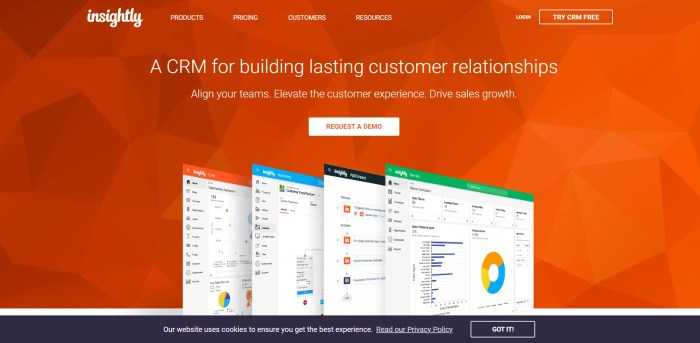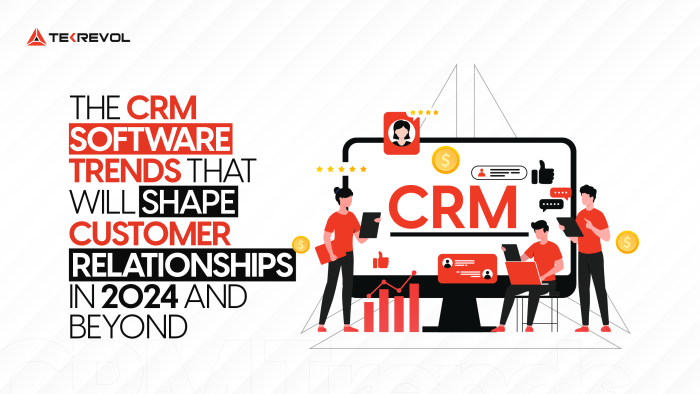CRM software for real-time customer data tracking revolutionizes how businesses understand and interact with their customers. By providing immediate access to crucial information like website activity, purchase history, and customer service interactions, businesses gain unprecedented insights into customer behavior. This allows for more effective decision-making, personalized marketing campaigns, and ultimately, improved customer satisfaction and increased sales.
This real-time data empowers businesses to proactively address customer needs, anticipate potential issues, and tailor their offerings to individual preferences. From optimizing marketing strategies to enhancing customer service responses, the benefits of real-time customer data tracking are far-reaching and transformative for any organization aiming to build stronger, more profitable customer relationships.
Real-Time Customer Data Tracking in CRM
In today’s fast-paced business environment, real-time access to customer data is no longer a luxury but a necessity. A robust Customer Relationship Management (CRM) system equipped with real-time data tracking capabilities provides businesses with a significant competitive edge, enabling informed decisions, personalized experiences, and ultimately, increased profitability. This article explores the key aspects of leveraging real-time customer data within a CRM system.
Benefits of Real-Time Customer Data Tracking
Real-time customer data tracking offers numerous advantages. Businesses gain immediate insights into customer behavior, preferences, and needs, leading to improved customer service, more effective sales strategies, and enhanced operational efficiency. This allows for proactive problem-solving and personalized interactions, fostering stronger customer relationships and increased loyalty.
Real-Time Data’s Impact on Customer Service and Sales
Real-time data significantly enhances both customer service and sales processes. In customer service, agents can access a complete customer history instantly, providing immediate and relevant solutions. For sales, real-time insights into customer engagement and purchasing patterns enable targeted campaigns and timely interventions, maximizing conversion rates.
Key Features of Real-Time CRM Software
Effective real-time CRM software incorporates several key features. These include dashboards displaying live customer metrics, automated alerts triggered by specific customer actions, seamless integration with various data sources, and robust reporting and analytics capabilities. Predictive analytics features can also provide valuable forecasting capabilities, enabling proactive adjustments to business strategies.
Data Sources and Integration
Real-time CRM systems draw data from diverse sources to create a unified view of the customer. Effective integration is crucial for maintaining data accuracy and consistency.
Common Data Sources for Real-Time Tracking
Common data sources integrated with real-time CRM include website analytics platforms (like Google Analytics), social media listening tools, point-of-sale (POS) systems, email marketing platforms, and customer support ticketing systems. Each source provides unique insights into customer interactions and behavior.
Ensuring Data Accuracy and Consistency
Maintaining data accuracy and consistency across integrated systems requires careful planning and execution. Data cleansing, validation rules, and regular audits are essential. Implementing standardized data formats and employing robust data governance processes are also vital.
Comparison of Data Integration Methods
| Integration Method | Advantages | Disadvantages | Example Use Case |
|---|---|---|---|
| APIs (Application Programming Interfaces) | Real-time data exchange, flexibility, scalability | Requires technical expertise, potential for integration complexities | Integrating website analytics data with CRM |
| ETL (Extract, Transform, Load) Processes | Batch processing of large datasets, data transformation capabilities | Not real-time, can be time-consuming, requires dedicated infrastructure | Consolidating data from multiple legacy systems |
| Cloud-Based Integration Platforms | Ease of use, pre-built connectors, scalability | Vendor lock-in, potential cost implications | Connecting CRM to marketing automation software |
| Direct Database Connections | High speed, direct access to data | Security concerns, requires database expertise | Integrating CRM with internal databases |
Real-time Data Visualization and Reporting
Effective visualization and reporting are essential for leveraging the power of real-time data. Dashboards and reports should provide clear, concise summaries of key metrics, enabling quick decision-making.
Real-Time Customer Metrics Dashboard
| Metric | Data Source | Visualization | Actionable Insight |
|---|---|---|---|
| Website Visits | Google Analytics | Line graph showing visits over time | Identify peak traffic times, optimize website content |
| Sales Conversion Rate | CRM, POS | Bar chart comparing conversion rates across different channels | Optimize sales funnels, improve marketing campaigns |
| Customer Support Tickets | Helpdesk Software | Real-time count of open tickets, categorized by urgency | Allocate resources effectively, improve response times |
| Average Order Value (AOV) | CRM, POS | Real-time AOV, segmented by customer group | Identify high-value customers, tailor offers |
Importance of Data Visualization for Decision-Making
Data visualization translates complex data into easily understandable formats, allowing for rapid identification of trends, patterns, and anomalies. This facilitates quicker and more informed decision-making, leading to improved business outcomes.
Examples of Effective Real-Time Reports, CRM software for real-time customer data tracking

Examples of effective real-time reports include sales performance dashboards, customer churn rate reports, and real-time campaign performance summaries. These reports provide timely insights, enabling businesses to adapt strategies and optimize performance in real-time.
Using Real-time Data for Personalized Customer Experiences
Real-time data empowers businesses to deliver highly personalized customer experiences across all touchpoints.
Personalized Marketing Campaigns and Offers
Real-time data allows for the creation of highly targeted marketing campaigns and offers based on individual customer preferences and behavior. This leads to increased engagement and conversion rates.
Improving Customer Segmentation and Targeting
Real-time data facilitates dynamic customer segmentation, enabling businesses to target specific customer groups with tailored messages and offers. This ensures that marketing efforts are more effective and efficient.
Personalizing the Customer Journey
Real-time data allows for the personalization of the customer journey across multiple channels, creating a seamless and consistent experience. This enhances customer satisfaction and loyalty.
Security and Privacy Considerations
Protecting sensitive customer data is paramount when implementing real-time data tracking. Robust security measures and adherence to data privacy regulations are essential.
Security Measures for Real-Time Data
Security measures should include data encryption, access control, regular security audits, and intrusion detection systems. Employing a multi-layered security approach is crucial to mitigating risks.
Compliance with Data Privacy Regulations
Businesses must comply with relevant data privacy regulations such as GDPR and CCPA. This involves obtaining explicit consent, providing data transparency, and implementing data subject access requests (DSAR) processes.
Potential Security Risks and Mitigation Strategies
- Data breaches: Implement robust security protocols, including encryption and access controls.
- Unauthorized access: Utilize strong authentication and authorization mechanisms.
- Data loss: Implement data backup and recovery procedures.
- Data manipulation: Regularly audit data for integrity and accuracy.
Choosing the Right CRM Software: CRM Software For Real-time Customer Data Tracking
Selecting the appropriate CRM software is crucial for successful real-time data tracking. Consider factors such as scalability, integration capabilities, and user-friendliness.
Comparing CRM Software Options
Different CRM platforms offer varying levels of real-time data capabilities. Consider factors such as the platform’s architecture, its ability to integrate with other systems, and the availability of real-time dashboards and reporting tools.
Key Factors for CRM Selection
- Real-time data capabilities
- Scalability and flexibility
- Integration with other systems
- User-friendliness and ease of use
- Security and compliance features
- Cost and ROI
Essential Features Checklist for Real-Time CRM
- Real-time dashboards and reports
- Automated alerts and notifications
- Seamless data integration capabilities
- Robust security and compliance features
- Predictive analytics capabilities
- Customizable workflows and automation
Case Studies and Best Practices
Successful implementation of real-time data tracking requires careful planning and execution. Learning from successful case studies and adopting best practices is crucial.
Examples of Successful Real-Time Data Utilization
Many businesses have successfully leveraged real-time customer data to improve their performance. For example, e-commerce companies use real-time data to personalize product recommendations, while customer service teams use it to provide faster and more effective support. These examples demonstrate the transformative potential of real-time data in enhancing customer experiences and driving business growth.
Best Practices for Implementation and Management
- Define clear objectives and key performance indicators (KPIs).
- Choose the right CRM software and integration methods.
- Implement robust data governance and security protocols.
- Train employees on how to use the system effectively.
- Continuously monitor and optimize the system for performance.
Overcoming Challenges in Implementation
Challenges in implementing real-time data tracking can include data integration complexities, security concerns, and the need for employee training. Addressing these challenges proactively is crucial for successful implementation.
Closing Summary

In conclusion, implementing CRM software for real-time customer data tracking offers a significant competitive advantage. By harnessing the power of immediate data insights, businesses can create more personalized customer experiences, optimize operational efficiency, and ultimately drive revenue growth. However, careful consideration of data security, privacy regulations, and the selection of the appropriate CRM system are crucial for successful implementation and maximizing the return on investment.
FAQ Overview
What is the cost of implementing CRM software for real-time data tracking?
Costs vary significantly depending on the chosen software, features required, and implementation complexity. Expect a range from affordable cloud-based options to enterprise-level solutions with higher price tags.
How long does it take to implement a real-time data tracking system?
Implementation timelines depend on factors like data integration complexity, system customization needs, and team expertise. Simple implementations might take weeks, while more complex projects could take months.
What are the risks associated with storing sensitive customer data in a real-time system?
Risks include data breaches, unauthorized access, and non-compliance with data privacy regulations. Robust security measures, including encryption, access controls, and regular security audits, are crucial to mitigate these risks.
